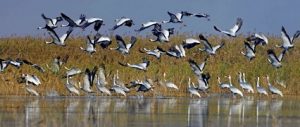Just before the Chinese New Year, Beijing-based non-profit group Friends of Nature wrote an open letter to members of China’s top government bodies – the National People’s Congress and Chinese People’s Political Consultative Conference – calling on them to urgently examine proposed changes to the boundaries of a national rare fish reserve on the upper reaches of the Yangtze River.
After 18 months of controversy over the plans, the Ministry of Environmental Protection (MEP) confirmed to Friends of Nature in November that the commission responsible for China’s national nature reserves had that month approved the changes. The proposal will now be submitted to the State Council for final sign off. Environmental groups worry that a decision in favour of redrawing the reserve’s boundaries will destroy the last remaining habitat on the Upper Yangtze for many rare fish species and, as a result, push them to extinction.
On December 2, seven Chinese environmental NGOs wrote to the MEP calling for a hearing on the plans. Their request has not been granted.
For 11 days in January, the MEP made the proposals available for public inspection. They include plans to shrink the reserve by 14.6 square kilometres in an area within the boundaries of Chongqing, a municipality in south-west China. More than 22 kilometres of river will be removed from the protected area and 73.3 kilometres currently classified as a buffer zone redesignated as an “experimental zone”.
An official at Chongqing’s Environmental Protection Bureau said: “The application to change the boundaries was made for the sake of Chongqing’s economic growth.” Chongqing aims to see GDP growth of 13.5% in 2011.
However, academics and NGO workers have pointed out that preliminary work on the Xiaonanhai dam is happening right in the area due to be removed from the reserve, while the reservoir site just happens to lie in the new “experimental zone”. They therefore conclude that the changes have been tailored for the specific purpose of allowing the dam development to proceed. One MEP official, who asked to remain anonymous, admitted that Chongqing’s proposals were connected to the push to construct the dam.
Friends of Nature’s director, Li Bo, said: “Intensive hydropower development on the upper reaches and tributaries of the Yangtze already means there is no more scope to shrink the nature reserve there.”
The campaign to maintain the reserve has been going on for almost two years. In 2009, several Chinese environmental NGOs wrote separately to the Chongqing government and members of the National Nature Reserve Commission to explain that the dam and new reserve boundaries would have grave consequences for the Upper Yangtze: the aquatic habitat provided by the free- flowing water would be damaged, there would be a major and irreversible ecological impact on numerous fish species and China’s aquatic biodiversity would be dealt a fatal blow.
Sun Shan, director of the Shan Shui Conservation Center, said: “The scale and frequency of dam cascades on the Upper Yangtze is cutting off migration routes for many rare and unique species of fish and halting the flowing water on which they depend. This reserve is their last refuge.”
As soon as they get the go-ahead from the State Council, the Xiaonanhai project owners – the Three Gorges Project Development Corporation – can start preparing for an environmental-impact assessment. However, they won’t need to wait for that assessment to get approval before starting to bring power, water and roads to the site, levelling ground for construction and even building a channel to divert the water while the dam is being built.
More worryingly, as soon as the reserve is downsized, dams at other locations such as Zhuchangxi and Shipeng will move up the agenda. Eventually, the Gezhou, Three Gorges, Xiaonanhai, Zhuchangxi and Wupeng dams will link together, stretching all the way to the two huge hydropower projects currently under construction at Xiangjia and Xiluodu.
“This reserve is basically cursed,” said Guo Qiaoyu, Yangtze River project manager for The Nature Conservancy in China. The reserve was originally created to deal with the ecological impact of the Three Gorges Dam, but has been repeatedly sliced up to allow for hydropower expansion.
The Three Gorges Dam has had a negative impact on about 40 different species of fish – some 40% of the fish species unique to the Upper Yangtze. In 1996, nature reserves were established around the cities of Luzhou and Yibin to protect rare fish, and in 1997 the Sichuan government combined these into the Hejiang-Leibo Rare Fish Provincial Nature Reserve. In April 2000, the State Council upgraded this to a National Nature Reserve. The reserve is home to the Chinese paddlefish, the Yangtze sturgeon and the Chinese high fin banded shark, which are all protected at national level, along with 64 fish unique to the Yangtze, including the largemouth bronze gudgeon.
In 2000, hydropower development reached the Jinsha River, the westernmost of the Yangtze’s headwater streams, and the sites picked out for the Xiangjia and Xiluodu dams were both inside the newly minted national reserve. To accommodate the dams, the reserve was renamed and downsized, to an area of around 332 square kilometres, containing 1,262 kilometres of river. And so the two dams were able to “legitimately” take over the fish reserve.
The Upper Yangtze is home to 230 species of fish, almost 100 of which have never been found anywhere else. This makes it one of the most important regions for unique fish species in the world. It is also home to protected fish that are only found in China, such as the Chinese sturgeon, the Chinese paddlefish, the Yangtze sturgeon, the Chinese high fin banded shark and the Sichuan taimen. But as hydropower development has accelerated, spawning grounds have been lost, habitats degraded and populations sharply reduced.
Prior to the 1970s, some of these species were plentiful, and even made up a significant part of commercial catches. But since the 1980s, populations have plunged and become too sparse for commercial fishing. Genetic diversity has also fallen sharply.
In 1989, the dam at Gezhou cut off migration routes for the Chinese sturgeon, removing it from the Upper Yangtze. Researchers at the Chinese Academy of Sciences’ Institute of Hydrobiology have found that, prior to the 1970s, the annual yield of Chinese paddlefish was about five tonnes. By 2003, there was no record of any catch at all; while populations of the Yangtze sturgeon and high fin banded shark were tiny.
The Yangtze’s dams prevent many species of fish from reaching spawning grounds, making extinction a real possibility. Professor Wang Kexiong, of the Institute of Hydrobiology, explained that, in 2006, experts from China and seven other nations surveyed numbers of black finless porpoise and found only 1,200 – around half the population of the previous decade. “If we don’t increase protection, we expect this species will be extinct in the wild in another 10 years,” said Wang. During the 2006 study, the scientists failed to find a single Chinese white dolphin, while the baiji or Chinese river dolphin was declared extinct in 2007.
With these rare and unique fish species facing obliteration, and only five years since the last change to its boundaries, the ill-fated river reserve now looks set to be dismantled further. Many environmentalists find this very difficult to accept.
Environmental groups point out that the recently published “China Biodiversity Protection Strategy and Action Plan (2011 to 2030)” clearly demands “stronger protection of rare and unique fish species and their habitats on the Upper Yangtze”. Slicing up the Jinsha River with more and more dams, and reducing the size of the area’s only national level fish reserve, runs contrary to this solemn undertaking by the Chinese government.
Han Ziyu (a pseudonym) is a reporter based in Beijing.
Homepage image from Opencage shows the Chinese high fin banded shark.


